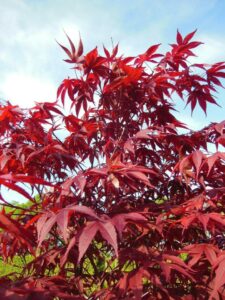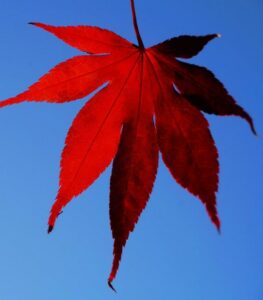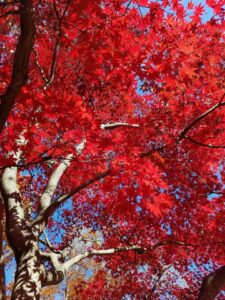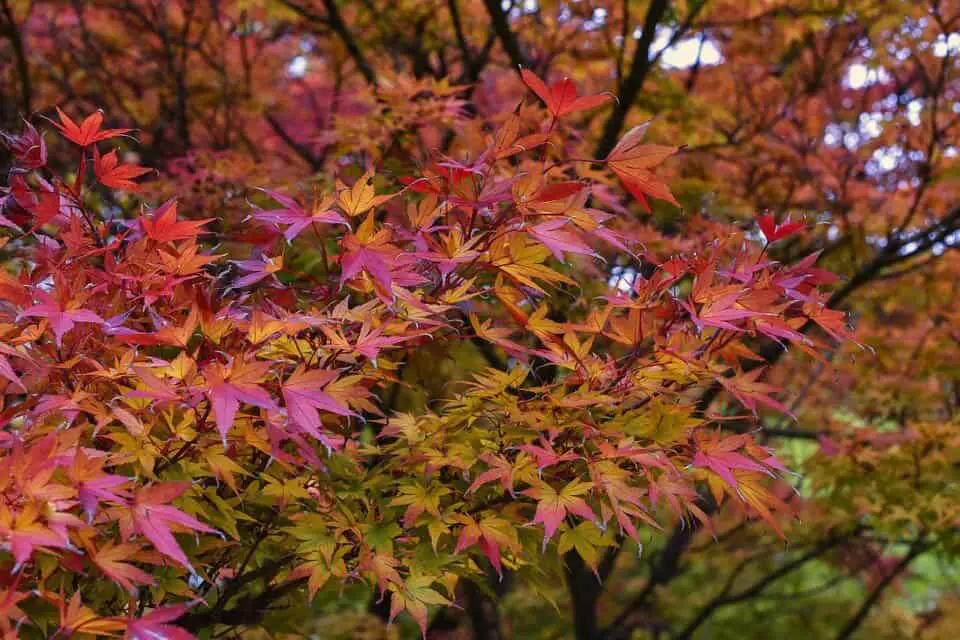Some links in the post are affiliate links and I get a commission from purchases made through some links found in the post.
Many gardeners love the changing colours of trees throughout the year.
The autumn colours can be spectacular with oranges, yellow, reds and even purple colours to brighten our gardens. In fact, many people travel long distances to see the colours changing.
Some gardeners actually design their gardens with the colour changes in mind, and this is a great idea until one or more of your trees does not change as you feel it should. What on earth is going on when our trusty Japanese Maple turns green?
Japanese Maple (Acer Palmatum) are famous for their striking colours. Indeed, these trees have been cultivated since the early 1600’s simply because of their beauty.
Japanese Maples are deciduous trees used mostly for their ornamental use of the foliage.
Having planned on using the beautiful foliage during the year, it can be confusing and worrying when your Japanese maple leaves are turning green.
The reason you Japanese maple is turning green is that it has been root stocked, fertilizer issues, incorrect lighting, nutrient and soil issues, seasonal changes and the trees age.
Some of these can be fixed with correct care whilst others are mainly out of your hands.
Why is your Japanese Maple Turning Green?
 First let’s look at how Maple trees are produced. Most trees that we find in our local garden centres are mass produced, normally using the most economical method possible.
First let’s look at how Maple trees are produced. Most trees that we find in our local garden centres are mass produced, normally using the most economical method possible.
Japanese Maples are no different. Often there are two parts of the tree which are combined to form one plant. This is known as grafting.
Growers and propagators will choose the roots and the lower section of a tree according to how fast and easily it can be propagated.
Two popular root stocks are those that are drought and disease resistant. These, called the rootstock, are what will be used to graft a decorative portion of tree onto.
Often, with Japanese Maples the rootstock is green leaved. The coloured Maple sections are grafted onto the rootstock.
As our Japanese Maple continues to grow the rootstock will develop shoots which you will be able to see below the graft line. They may even send out suckers.
Unless these shoots and suckers are frequently removed, you will eventually have a green leaved Japanese Maple tree. Basically, the greet leaved rootstock will dominate the coloured graft and overpower it.
How do we fix this?
Almost every named variety of the Japanese Maple has come from grafting and new growth spurting from below the graft line.
You will need to constantly watch out for suckers appearing and shoots growing out of the rootstock portion of the tree. They should be trimmed or removed to keep the coloured variety healthy.
A point to note here about grated trees is that if they are damaged by winter stress or rodents and insects, the new growth may be coming from the rootstock rather than the named variety of the tree.
There are several other reasons why your Japanese Maple turns green.
1) Incorrect lighting
If your Japanese Maple does not receive enough natural light it may start to turn green rather than stay red or yellow.
Although the Japanese Maple prefers full sunlight, it can do well in partial shade, although if too much shade falls on the tree it will turn green.
The Japanese Maple needs at least 6 hours each day where it is in full sun. For this reason, you may often see them planted in the centre of a lawn area where there is no chance of shade from an overhanging building or any other trees.
How to fix this
If you feel that your Maple is suffering from lack of lighting, then you should plan on moving it sooner rather than later. Established trees take longer to settle down and are more difficult to move than younger ones.
You may also like: 6 benefits of a owning a Japanese maple
2) Nutrient and soil issues
Your Japanese Maple will do best in soil, which is well-drained because, as with many plants, they do not like their roots to be too wet.
The Maple also needs soil, which is more acidic and higher in organic matter, so if you have a compost heap you can happily use it on your Maple.
When Maples are grown in poor soil you will find that the growth rate is slower, and the tree becomes stressed. This can lead to the foliage turning green rather than staying red.
Both poor soil and overfertilization can cause the Japanese Maple to be turning green. You should have the soil around it tested to ensure that there is no nutrient deficiency for the tree.
The most common deficiency for the Japanese Maple is a lack of Magnesium. This will show up as yellow/green leaves with darker veins.
A note here: there is no need to fertilize a newly planted Maple as the roots cannot take in the nutrients. Once established the tree can be fertilized in the spring before any new growth starts.
You should aim for a slow-release fertilizer because it will continue to work over the growing season, thus supplying the tree with a constant source of nutrients. ON the ingredients you should find ‘water insoluble nitrogen.’
How to fix this
Testing the soil is relatively inexpensive and can set your mind at rest that there are no other issues. Once you know what is lacking you will be able to set up a feeding routine to restore the colourful leaves through the year.
3) Light Intensity
 In hot climates you should plant your Japanese Maple in a spot where it receives sunlight in the morning and dappled shade in the afternoons as this is when the sun is at its fiercest.
In hot climates you should plant your Japanese Maple in a spot where it receives sunlight in the morning and dappled shade in the afternoons as this is when the sun is at its fiercest.
Your Japanese Maple can receive too much sun, although this will now cause the foliage to be turning green. Rather it will develop brown leaves, as if they are being scorched.
In extremely hot climates you would be better planting your Maple in a semi-shade area, certainly where the afternoon sun is not so vicious.
How to fix this
As long as the tree receives its 6 hours of direct sunlight, it will do well in a dappled shade area in the afternoons.
There are some types of Maple which change from red to green if the sunlight is too intense so you should check with your local garden centre before selecting your tree.
You may also like: Japanese maple vs red maple
4) Normal Seasonal Changes
Typically, the Japanese Maple colours up in the spring and the fall so if you are seeing green leaves in the summer, be aware that some types do turn green in the summertime and will colour up later in the year.
There are some varieties that only change colour in the fall, so the leaves will turn green at other times. If your Maple is one of them then you will not have the vivid colours all the year.
How to fix this
If you plan to have the colours of your Maple as a part of your garden décor, then be sure to buy the variety that does this. A reputable garden centre will be able to tell you which ones will do this.
5) The Tree’s Age
Occasionally the Maple will lose its coloured leaves when growing vigorously and this is a normal process. You will find that the tree naturally slows the rate of growth, and when this happens it will revert to reds and oranges.
Older Maples seem to be more regular in the appearance of red leaves than younger trees who often deliver green foliage.
There is not much that you can do about a young tree with green leaves apart from look forward to the colours which will appear over the coming years.
How to fix this
There is nothing you can do as the tree ages as this is the normal part of the growth process.
However, if you must have a red foliage Maple then you may be able to order one from a reputable garden centre. They may need to order it for you, but it can be done.
6) Green Stock Trees
We often find that coloured cultivars are grafted onto greet rootstock, and if one of the shoots is mistaken for the coloured variety, the leaves will be green. Make sure to check where the new growth is coming from.
You will normally be able to see a slight bump where the grafting has occurred and any shoots coming from below this will reflect the original rootstock and not the coloured top portion.
How to fix this
Make sure you prune all the shoots which grow from below the rootstock, and the bump area where the graft was made.
A note about your planting area:
While the Japanese Maple certainly looks best in the centre of the lawn, it can be grown closer to your house. There are some things to take into consideration when doing this.
- Check the distance – try to plant no closer than 10’ as the tree grows outwards as well as upwards.
- Check the overhangs – the last thing you will want to do is chop down your Maple because it is getting too tall for any overhang. Find out the growth height from the garden centre.
- Watch for cables – again, it would be such a shame to need to chop down a Maple because of electricity cables above it.
- Watch for drainpipes – in very heavy rain seasons be sure that the soil around your Maple drains well and it does not receive all the water from drainpipes close to it.
For more on where to plant a Japanese maple, check out our article here.
How do you Keep a Japanese Maple Red?
Possibly the most common reason for your Japanese Maple to be turning green is down to the light it receives. For your tree to stay red, it must have sunlight.
Too much shade and the red foliage for which the trees are famous simply do not show up. Rather, the foliage develops as green. They may be vaguely reddish, but nothing compared to what you can expect for a Maple in correct sunlight.
To keep your Maple red there are some things to pay attention to, namely:
- Water and fertilizer – Never overfertilize or water the tree in the fall
- Right conditions – at least 6 hours of direct sunlight
- Right soil conditions – a Japanese Maple prefers soil which has a pH which does not suit it. Both too acidic and too alkaline will cause green foliage. Maples prefer neutral soil.
Final Thoughts
 The Japanese Maple is a tree which should take pride of place in your garden – and this is exactly where it will be happiest, because in the middle of the garden is where the tree will receive the most sunlight.
The Japanese Maple is a tree which should take pride of place in your garden – and this is exactly where it will be happiest, because in the middle of the garden is where the tree will receive the most sunlight.
Japanese Maples need at least 6 hours of direct sunlight to produce the spectacular foliage we love so much. They will never do well in shady spots so best not to plant anywhere near a place like that.
The more direct sunlight your Japanese Maple is exposed to, the more colour pigments the tree will produce and with a little bit of maintenance – and this is a low maintenance tree – you will be rewarded year after year with the most spectacular displays of foliage ranging from red to burgundy and bright yellow.


